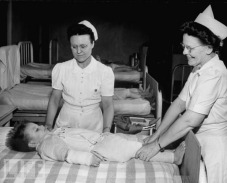Polio Strikes

Young polio victims in the 1950's
(collectionscanada.gc.ca)
(collectionscanada.gc.ca)
Throughout human history, polio caused paralysis and death. The first identifiable American outbreak occurred in 1894. In 1952, nearly 60,000 cases were reported in the US with more than 3,000 deaths. (See Map of Cases 1952 and Mortality Tables for period.)
An individual with polio was quarantined in a hospital before being sent to a treatment center. Mrs. Donna Alexander, who contracted polio in 1953, told us, “I was sent to a treatment hospital hours away from my home which meant I could not see my friends or parents.”
The people affected the most by polio might spend years in an iron lung that aided their breathing.
An individual with polio was quarantined in a hospital before being sent to a treatment center. Mrs. Donna Alexander, who contracted polio in 1953, told us, “I was sent to a treatment hospital hours away from my home which meant I could not see my friends or parents.”
The people affected the most by polio might spend years in an iron lung that aided their breathing.
Treatments

Sister Kenny's method of treatment
(life.com)
(life.com)
There was no known cure for polio, only treatments to ease the pain and increase mobility. Sister Kenny’s used hot packs and stretching exercises.
Lauren Friesen received the Sister Kenny treatment. He wrote in his letter to us: "They would come with what looked like a large, floor model pressure cooker that heated the itchy blankets and I would be rolled over (no muscle exertion on my part was allowed) onto my stomach and then the hot packs would be taken out of the cooker and while still steaming hot placed on my back. I think this was every 2 hours for that first 2 weeks. After that week, I was awake during normal hours and I think the sedatives were stopped during daytime. I don't recall any stretching exercises for these first 2 weeks. The third week I was moved to a ward that had 16 male patients. I was the youngest and their ages went up into the 40s. Toward the end of the week, I was taken out of the bed and asked to hold onto a walker (early models) and walk. I immediately fell down. All of the men in this room were keenly aware of this and thought I'd never walk again. "
Lauren Friesen received the Sister Kenny treatment. He wrote in his letter to us: "They would come with what looked like a large, floor model pressure cooker that heated the itchy blankets and I would be rolled over (no muscle exertion on my part was allowed) onto my stomach and then the hot packs would be taken out of the cooker and while still steaming hot placed on my back. I think this was every 2 hours for that first 2 weeks. After that week, I was awake during normal hours and I think the sedatives were stopped during daytime. I don't recall any stretching exercises for these first 2 weeks. The third week I was moved to a ward that had 16 male patients. I was the youngest and their ages went up into the 40s. Toward the end of the week, I was taken out of the bed and asked to hold onto a walker (early models) and walk. I immediately fell down. All of the men in this room were keenly aware of this and thought I'd never walk again. "
Breakthroughs That Helped Salk Develop His Vaccine

Polio Virus
(purdue.edu)
(purdue.edu)
In the 1930’s, scientists proved that the polio virus entered the body through the intestinal track disproving earlier beliefs that it never entered the bloodstream. This showed that a vaccine, if developed, could be effective.
Before Salk could develop his vaccine, the poliovirus had to be identified and isolated. In the 1940’s, studies found that just three viruses out of the 125 identified were responsible for most of the cases of polio in the United States.
A third breakthrough needed was a way to manufacture a ready supply of the virus. In 1947, Dr. Enders discovered how to grow polio in cell cultures, providing a large supply.
Before Salk could develop his vaccine, the poliovirus had to be identified and isolated. In the 1940’s, studies found that just three viruses out of the 125 identified were responsible for most of the cases of polio in the United States.
A third breakthrough needed was a way to manufacture a ready supply of the virus. In 1947, Dr. Enders discovered how to grow polio in cell cultures, providing a large supply.